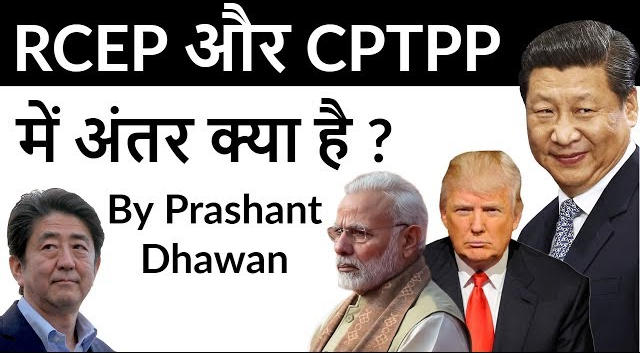Table of Contents
IMPORTANT FREE TRADE AGREEMENTS
- RCEP and the CPTPP The Regional Comprehensive Economic Partnership Comprehensive and Progressive Agreement for Trans-Pacific Partnership
BASIC OF RCEP
- The Regional Comprehensive Economic Partnership (RCEP) is a proposed free trade agreement (FTA) between the ten member states of the Association of Southeast Asian Nations (ASEAN) (Brunei, Cambodia, Indonesia, Laos, Malaysia, Myanmar, the Philippines, Singapore, Thailand, Vietnam) and the six Indo-Pacific states with which ASEAN has existing free trade agreements (China, Japan, South Korea, India, Australia and New Zealand).
RCEP


RCEP DETAILS
- Zero tariffs over 90 per cent tariff lines India has already liberalised its 80 per cent tariff lines with its FTA partners and a significant volume of trade takes place under zero tariff. For non-FTA partners such as China, Australia and New Zealand, it has proposed tariff liberalisation on 74 per cent of tariff lines and it is opposed to the industry demand of 42 per cent tariff lines.
RCEP ROAD BLOCK
- While looking at trade in engineering goods with individual members of RCEP, it is important to note that India has a trade deficit with seven RCEP countries which include China, Singapore, South Korea, Malaysia, Thailand, Japan and Australia. But, China contributes 60 per cent to the total trade deficit of engineering goods of India with the RCEP group of countries.
CHINA’S FRUSTRATION
- The current development highlights an interesting juncture where China has indicated that it is ready to push forward negotiations with ASEAN+3 (which includes the ten-member ASEAN, China, Japan and South Korea) if its proposal on liberalisation of 90 per cent tariff lines is not considered.
COMPREHENSIVE AND PROGRESSIVE AGREEMENT FOR TRANS-PACIFIC PARTNERSHIP

CPTPP
- A trade agreement between Australia, Brunei, Canada, Chile, Japan, Malaysia, Mexico, New Zealand, Peru, Singapore, and Vietnam.
THE ORIGINS
- The Trans-Pacific Partnership (TPP) was an ambitious trade agreement involving 12 countries that encompassed 40 per cent of the world’s economy and over 800 million consumers. The member countries were Japan, Vietnam, Brunei, Malaysia, Singapore, Australia, New Zealand, Canada, the US, Mexico, Peru and Chile.
- The deal was signed in 2016 but it was never ratified by the US Congress. The pact became a target of criticism from both rightwing and left-wing pundits and US President Donald Trump withdrew from it on his first day in office, in January 2017. However, the rest of the signatories agreed to a revised version of the deal, known as the Comprehensive and Progressive Agreement for Trans-Pacific Partnership (CPTPP) The CPTPP covers more than 13 per cent of world GDP, or a total of US$10 trillion dollars. All member countries are expected to receive a boost to their economies from lower tariffs and increased market access.






















 WhatsApp
WhatsApp